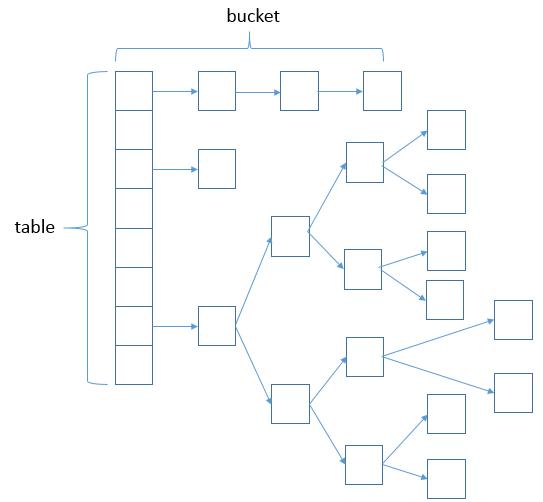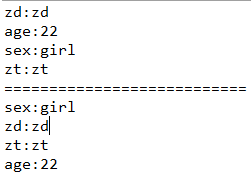一、HashMap
- 基于哈希表的 Map 接口的实现,允许存入 null 值和 null 键,无序存储且线程不同步;
- HashMap 初始容量默认为16,扩容一定是2的指数,加载因子默认值为0.75;
- HashMap采用Iterator方式迭代,可直接迭代键值对;
- 迭代 collection 视图所需的时间与 HashMap 实例的“容量”(桶的数量)及其大小(键-值映射关系数)成比例。所以,如果迭代性能很重要,则不要将初始容量设置得太高(或将加载因子设置得太低)。
建议多看源码,如果觉得晦涩可以戳这里看源码解析。
安利网址:http://www.admin10000.com/document/3322.html,个人觉得分析的挺好
JDK1.8+HashMap的改进

- JDK1.8以前是采用的数组+链表形式存储,JDK1.8+是采用的是数组+链表/红黑树
- JDK1.8+,当bucket节点数小于等于6时,转换为链表形式;当节点数大于等于8时,转换为红黑树形式
JDK1.8以前,HashMap的put()方法、get()源码如下:
put():
public V put(K key, V value) {
// HashMap允许存放null键和null值。
// 当key为null时,调用putForNullKey方法,将value放置在数组第一个位置。
if (key == null)
return putForNullKey(value);
// 根据key的hashCode重新计算hash值。
int hash = hash(key.hashCode());
// 搜索指定hash值所对应table中的索引。
int i = indexFor(hash, table.length);
// 如果 i 索引处的 Entry 不为 null,通过循环不断遍历 e 元素的下一个元素。
for (Entry<K,V> e = table[i]; e != null; e = e.next) {
Object k;
if (e.hash == hash && ((k = e.key) == key || key.equals(k))) {
V oldValue = e.value;
e.value = value;
e.recordAccess(this);
return oldValue;
}
}
// 如果i索引处的Entry为null,表明此处还没有Entry。
// modCount记录HashMap中修改结构的次数
modCount++;
// 将key、value添加到i索引处。
addEntry(hash, key, value, i);
return null;
}get():
public V get(Object key) {
// 如果 key 是 null,调用 getForNullKey 取出对应的 value
if (key == null)
return getForNullKey();
// 根据该 key 的 hashCode 值计算它的 hash 码
int hash = hash(key.hashCode());
// 直接取出 table 数组中指定索引处的值,
for (Entry<K, V> e = table[indexFor(hash, table.length)]; e != null;
// 搜索该 Entry 链的下一个 Entr
e = e.next) // ①
{
Object k;
// 如果该 Entry 的 key 与被搜索 key 相同
if (e.hash == hash && ((k = e.key) == key || key.equals(k)))
return e.value;
}
return null;
}JDK1.8+,HashMap的put()、get()方法源码如下:
put():
public V put(K key, V value) {
return putVal(hash(key), key, value, false, true);
}
final V putVal(int hash, K key, V value, boolean onlyIfAbsent,
boolean evict) {
Node<K,V>[] tab; Node<K,V> p; int n, i;
// table未初始化或者长度为0,进行扩容
if ((tab = table) == null || (n = tab.length) == 0)
n = (tab = resize()).length;
// (n - 1) & hash 确定元素存放在哪个桶中,桶为空,新生成结点放入桶中(此时,这个结点是放在数组中)
if ((p = tab[i = (n - 1) & hash]) == null)
tab[i] = newNode(hash, key, value, null);
// 桶中已经存在元素
else {
Node<K,V> e; K k;
// 比较桶中第一个元素(数组中的结点)的hash值相等,key相等
if (p.hash == hash &&
((k = p.key) == key || (key != null && key.equals(k))))
// 将第一个元素赋值给e,用e来记录
e = p;
// hash值不相等,即key不相等;为红黑树结点
else if (p instanceof TreeNode)
// 放入树中
e = ((TreeNode<K,V>)p).putTreeVal(this, tab, hash, key, value);
// 为链表结点
else {
// 在链表最末插入结点
for (int binCount = 0; ; ++binCount) {
// 到达链表的尾部
if ((e = p.next) == null) {
// 在尾部插入新结点
p.next = newNode(hash, key, value, null);
// 结点数量达到阈值,转化为红黑树
if (binCount >= TREEIFY_THRESHOLD - 1) // -1 for 1st
treeifyBin(tab, hash);
// 跳出循环
break;
}
// 判断链表中结点的key值与插入的元素的key值是否相等
if (e.hash == hash &&
((k = e.key) == key || (key != null && key.equals(k))))
// 相等,跳出循环
break;
// 用于遍历桶中的链表,与前面的e = p.next组合,可以遍历链表
p = e;
}
}
// 表示在桶中找到key值、hash值与插入元素相等的结点
if (e != null) {
// 记录e的value
V oldValue = e.value;
// onlyIfAbsent为false或者旧值为null
if (!onlyIfAbsent || oldValue == null)
//用新值替换旧值
e.value = value;
// 访问后回调
afterNodeAccess(e);
// 返回旧值
return oldValue;
}
}
// 结构性修改
++modCount;
// 实际大小大于阈值则扩容
if (++size > threshold)
resize();
// 插入后回调
afterNodeInsertion(evict);
return null;
}get():
public V get(Object key) {
Node<K,V> e;
return (e = getNode(hash(key), key)) == null ? null : e.value;
}
final Node<K,V> getNode(int hash, Object key) {
Node<K,V>[] tab; Node<K,V> first, e; int n; K k;
// table已经初始化,长度大于0,根据hash寻找table中的项也不为空
if ((tab = table) != null && (n = tab.length) > 0 &&
(first = tab[(n - 1) & hash]) != null) {
// 桶中第一项(数组元素)相等
if (first.hash == hash && // always check first node
((k = first.key) == key || (key != null && key.equals(k))))
return first;
// 桶中不止一个结点
if ((e = first.next) != null) {
// 为红黑树结点
if (first instanceof TreeNode)
// 在红黑树中查找
return ((TreeNode<K,V>)first).getTreeNode(hash, key);
// 否则,在链表中查找
do {
if (e.hash == hash &&
((k = e.key) == key || (key != null && key.equals(k))))
return e;
} while ((e = e.next) != null);
}
}
return null;
}参考网址:
JDK1.8以前:http://www.cnblogs.com/xwdreamer/archive/2012/06/03/2532832.html
JDK1.8+:http://www.cnblogs.com/leesf456/p/5242233.html
二、Hashtable(小写t!!!)
- 基于哈希表的 Dictionary 接口的实现,不允许存入 null 键和 null 值,无序存储且线程同步;
- Hashtable采用的是Enumeration<T>迭代方式,key和value需要分别调用keys()和elements();
- HashTable中hash数组默认大小是11,增加的方式是 oldCapacity * 2 + 1。
Dictionary<String, String> dic = new Hashtable<String, String>();
dic.put("zd", "zd");
dic.put("age", "21");
dic.put("zt", "zt");
dic.put("age", "22");
dic.put("sex", "girl");
Enumeration<String> elemvalues = dic.elements();
Enumeration<String> elemkeys = dic.keys();
while(elemvalues.hasMoreElements() && elemkeys.hasMoreElements()){
System.out.print(elemkeys.nextElement()+":");
System.out.println(elemvalues.nextElement());
}更多详情看源码或戳这里。
三、LinkedHashMap
- LinkedHashMap继承于HashMap,不同于HashMap,采用的是双向链表方式实现,并且定义了迭代顺序,默认顺序为插入元素的顺序。
- LinkedHashMap还提供了一个可以指定是默认排序(插入排序)还是按照访问排序的构造方法,如下:
- public LinkedHashMap(int initialCapacity, float loadFactor, boolean accessOrder)
- initialCapacity:初始容量,默认为16
- loadFactor:装载因子,默认为0.75
- accessOrder:true,按照访问排序;false,按照插入排序
- 访问排序采用的是LRU最近最少使用的调度算法
- public LinkedHashMap(int initialCapacity, float loadFactor, boolean accessOrder)
- HashMap可以向Entry的key和value存入null,LinkedHashMap也允许插入null键和null值。
- 不是线程同步类。如果多线程同时访问LinkedHashMap,并且至少有一个线程会对其修改,则必须采用外部同步,如synchronized同步方法或synchronized同步块。还有种方法就是采用Collections工具类中的synchronizedMap()方法,如:
- Map m = Collections.synchronizedMap(new LinkedHashMap(Object));
LinkedHashMap默认为插入顺序排序,HashMap为无序:
public static void main(String[] args) {
// TODO Auto-generated method stub
Map<String, String> linkmap = new LinkedHashMap<String, String>();
linkmap.put("zd", "zd");
linkmap.put("age", "21");
linkmap.put("sex", "girl");
linkmap.put("zt", "zt");
linkmap.put("age", "22");
for(Entry<String, String> entry:linkmap.entrySet()){
System.out.println(entry.getKey()+":"+entry.getValue());
}
System.out.println("===========================");
Map<String, String> hashmap = new HashMap<String, String>();
hashmap.put("zd", "zd");
hashmap.put("age", "21");
hashmap.put("zt", "zt");
hashmap.put("age", "22");
hashmap.put("sex", "girl");
for(Entry<String, String> entry:hashmap.entrySet()){
System.out.println(entry.getKey()+":"+entry.getValue());
}
}结果展示:

更多详情看源码或者戳这里。
三、ConcurrentHashMap
- ConcurrentHashMap是since JDK1.5;
- ConcurrentHashMap是线程同步的;
- ConcurrentHashMap将数据分为多个segment,默认16个;
- ConcurrentHashMap允许多个修改操作并发进行,因为每次只锁相应的segment,除类似size()和containsValue()方法等需要锁住整个hash表。
更多详情看源码或者戳这里。
优秀博文:http://www.cnblogs.com/yydcdut/p/3959815.html
四、TreeMap
- TreeMap通过红黑树算法实现;
- TreeMap是有序的,可通过实现Comparator接口实现定制排序方式。
红黑树5点规定:
- 每个节点都只能是红色或者黑色
- 根节点是黑色
- 每个叶节点(NIL节点,空节点)是黑色的。
- 如果一个结点是红的,则它两个子节点都是黑的。也就是说在一条路径上不能出现相邻的两个红色结点。
- 从任一节点到其每个叶子的所有路径都包含相同数目的黑色节点。
更多详情请戳这里,本人觉得讲的很详细,对红黑树也作了详细的阐述。
五、EnumMap
EnumMap是专门为枚举类型量身定做的Map实现。虽然使用其它的Map实现(如HashMap)也能完成枚举类型实例到值得映射,但是使用EnumMap会更加高效:它只能接收同一枚举类型的实例作为键值,并且由于枚举类型实例的数量相对固定并且有限,所以EnumMap使用数组来存放与枚举类型对应的值。这使得EnumMap的效率非常高。
提示:EnumMap在内部使用枚举类型的ordinal()得到当前实例的声明次序,并使用这个次序维护枚举类型实例对应值在数组的位置。
下面是使用EnumMap的一个代码示例。枚举类型DataBaseType里存放了现在支持的所有数据库类型。针对不同的数据库,一些数据库相关的方法需要返回不一样的值,示例中getURL就是一个。
//现支持的数据库类型枚举类型定义
public enum DataBaseType{
MYSQL,ORACLE,DB2,SQLSERVER
}//DataBaseInfo类中定义的获取数据库URL的方法以及EnumMap的声明。
public class DataBaseInfo{
private EnumMap<DataBaseType, String> urls = new EnumMap<DataBaseType, String>(DataBaseType.class);
public DataBaseInfo(){
urls.put(DataBaseType.DB2,"jdbc:db2://localhost:5000/sample");
urls.put(DataBaseType.MYSQL,"jdbc:mysql://localhost/mydb");
urls.put(DataBaseType.ORACLE,"jdbc:oracle:thin:@localhost:1521:sample");
urls.put(DataBaseType.SQLSERVER,"jdbc:microsoft:sqlserver://localhost:1433;DatabaseName=mydb");
}
}/**
* 根据不同的数据库类型,返回对应的URL
* @param type DataBaseType枚举类新实例
*/
public String getURL(DataBaseType type){
return this.urls.get(type);
}在实际使用中,EnumMap对象urls往往是由外部负责整个应用初始化的代码来填充的。
该博文仅作为复习记录,大多数原理及源码解释已给出链接,优秀博客需要一起共赏。最后,若有错误,望纠正。
来源:oschina
链接:https://my.oschina.net/u/2756867/blog/729795